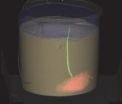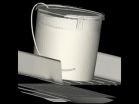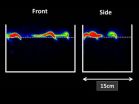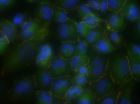(Press-News.org) The seabed is inhabited by vast numbers of small animals with hidden lives in the sandy sediments. Here they play an important role in keeping the oceans healthy. But how these animals behave and interact with each other is unclear, as it is not possible to see them without disturbing the sediment.
Researchers like Ph.D. Matthieu Delefosse would enjoy putting on a pair of X-ray glasses and study the sediment living animals without disturbing them.
"We know bits and pieces of what these animals do through different measurements/experiments, but we do not have an integrated method that allows us to measure these bits and pieces in the same time in a natural environment", he explains.
This inspired him to use a PET/CT scanner in his studies of benthic life. The results of this effort are published in the journal PLOS ONE.
Matthieu Delefosse was at Department of Biology, University of Southern Denmark, when he performed his benthic studies. Today he works as an environmental advisor for Maersk Oil and Gas.
"Our study has shown that it is possible to take a look into the natural life of benthic animals by scanning them in a relatively undisturbed environment. It could be interesting to use this technique to verify and develop further ecological models to scan real life samples with natural assemblages of animals and see what the scanner reveals: Which animals live in the area? And how do they behave and impact their surroundings?", he says.
To test his idea Matthieu Delefosse filled 10 liter buckets with sediment from Bregnør Bight in Odense Fjord, Denmark. The buckets were left for 8-10 days, so their content of sediment could compact and lugworms (Arenicola marina) establish themselves. Five buckets were scanned, and Delefosse observed how their varying contents of lugworms behaved.
One bucket contained one worm that burrowed through the sand, pushing water in front of itself, so that the water eventually saturated the sand in the bottom of the bucket.
"Another bucket had more worms, and we could see how three of them buried while a fourth stayed on the surface."
According to Matthieu Delefosse it is important to understand the behavior and activities of benthic animals.
"Their activities have a significant impact on the health of marine systems. Take lugworms - they bury in the sediments in search of microalgae to eat. Like other animals, they need oxygen and get it from the surrounding water, pumping it down into their burrows. This transports oxygen into the sediments", he explains.
The PET/CT scannings of lugworms were made possible by Professor Poul Flemming Høilund-Carlsen, Nuclear Medicine Department at Odense University Hospital.
"This interdisciplinary collaboration is an excellent example of how researchers from different fields and specialties should meet and try to solve tasks that can only be solved by interdisciplinary collaboration. Here we have large hospital scanners, a cyclotron and radiochemical laboratories that are normally used to help patients. Even though they work both days, evenings and on Saturdays there are still many hours where the equipment is not in use and can be used by researchers from other fields. Using the equipment for interdisciplinary research in these hours can lead to very interesting scientific results", says Poul Flemming Høilund-Carlsen.
INFORMATION:
Contact: Matthieu Delefosse, Telephone +45 60477950, email: matthieu.delefosse@gmail.com
Film and image descriptions:
Film 002 and image: A bucket contains sand (grey) and a lugworm has from the surface down to the bottom of the bucket (the burrow is shown in green). At the bottom there is a red volume; the worm has pushed so much water in front of itself that the water has saturated the sand in the red zone.
Film 005: The dotted line is the surface of the sand in the bucket. The red movements illustrate lugworms in motion. Three worms are burying into the sand while a fourth stays at the surface.
Journal ref: Seeing the Unseen - Bioturbation in 4D: Tracing Bioirrigation in Marine Sediment Using Positron Emission Tomography and Computed Tomography. Matthieu Parts Fosse, Erik Kristensen, Diane Crunelle, Poul Erik sting, Johan Hygum Dam, Helge Thisgaard, Anders Thomassen, Poul Flemming Høilund-Carlsen.
http://journals.plos.org/plosone/article?id=10.1371/journal.pone.0122201
Researchers at Genes and Cancer group at Bellvitge Biomedical Research Institute (IDIBELL), led by Montse Sanchez-Cespedes, have identified the PARD3 gene as a tumor suppressor that is inactivated in lung cancer squamous type. The results of the study have been published in Cancer Research.
Correct polarization (orientation in space) of bronchial epithelial cells is essential for the maintenance and proper development of this tissue under normal conditions.
PARD3 gene encodes a protein that regulates cell polarization and cell junctions. When the gene is inactivated, ...
Scientists at the University of Sheffield calculate that all of the UK's high level nuclear waste from spent fuel reprocessing could be disposed of in just six boreholes 5km deep, fitting within a site no larger than a football pitch.
The concept - called deep borehole disposal - has been developed primarily in the UK but is likely to see its first field trials in the USA next year. If the trials are successful, the USA hopes to dispose of its 'hottest' and most radioactive waste - left over from plutonium production and currently stored at Hanford in Washington State ...
Simply declaring a region as a nature protection area is not enough, regular monitoring of its ecological condition is also necessary. Since Nature protection areas already cover almost one fifth of the surface of the European Union, it is impossible to inspect such a vast area in the traditional way on foot. Therefore, new methods are being developed to monitor Europe's nature protection areas from the air. Short laser pulses are sent to the ground, and information on the status of the habitat can be deduced from the reflected light signals using elaborate computer algorithms.
Laser ...
Cancer Mortality Reductions Were Greatest Among Countries Where Cancer Care Spending Rose The Most, 1995-2007.
Warren Stevens of Precision Health Economics, Dana P. Goldman of the Schaeffer Center for Health Policy and Economics at the University of Southern California, and coauthors compared cancer care across sixteen countries over time, examining changes in cancer spending and two measures of cancer mortality (amenable and excess mortality). They found that, compared to low-spending health systems, high-spending systems had consistently lower cancer mortality in the ...
Fast Facts:
More than 30,000 people in the U.S. are diagnosed with Lou Gehrig's disease, or amyotrophic lateral sclerosis (ALS).
Johns Hopkins researchers have transformed skin cells donated by ALS patients into brain cells affected by the progressive, fatal disease.
The resulting cell library is being used by researchers worldwide in the quest for better ALS treatments.
Researchers at Johns Hopkins Medicine have transformed skin cells from patients with Lou Gehrig's disease, or amyotrophic lateral sclerosis (ALS), into brain cells affected by the progressive, ...
The World Health Organization (WHO) have announced a new statement on the public disclosure of clinical trial results which updates and expands a previous statement that noted the "the registration of all interventional trials is a scientific, ethical, and moral responsibility." The new statement includes timelines by which researchers are expected to report clinical trials results. In an Essay published in this week's PLOS Medicine Vasee Moorthy and colleagues from the WHO outline the rationale behind the new statement.
A new element in the WHO statement is the definition ...
Extreme hazards - rare, high-impact events - pose a serious and underestimated threat to humanity. The extremes of the broad ensemble of natural and anthropogenic hazards can lead to global disasters and catastrophes. Because they are rare and modern society lacks experience with them, they tend to be ignored in disaster risk management. While the probabilities of most natural hazards do not change much over time, the sensitivity of the built environment and the vulnerability of the embedded socio-economic fabric have increased rapidly. Exposure to geohazards has increased ...
April 14, 2015 A new material developed at the University of Colorado Boulder could radically reduce the energy needed to produce a wide variety of plastic products, from grocery bags and cling wrap to replacement hips and bulletproof vests.
Approximately 80 million metric tons of polyethylene is produced globally each year, making it the most common plastic in the world. An essential building block for manufacturing polyethylene is ethylene, which must be separated from a nearly identical chemical, ethane, before it can be captured and used.
The similarities between ...
Researchers from the RIKEN Center for Emergent Matter Science in Japan have uncovered the first evidence of an unusual quantum phenomenon--the integer quantum Hall effect--in a new type of film, called a 3D topological insulator. In doing this, they demonstrated that "surface Dirac states"--a particular form of massless electrons--are quantized in these materials, meaning that they only take on certain discrete values. These discoveries could help move science forward toward the goal of dissipationless electronics--electronic devices that can operate without producing the ...
SAN DIEGO (April 14, 2015) -- A team of biologists from San Diego State University has developed a platform for identifying drugs that could prove to be effective against a variety of viral diseases. In a pair of recent articles in the Journal of Biomolecular Screening and the Journal of Visualized Experiments, the researchers describe how the methodology works, using dengue virus as an example, and they identify a novel drug which may someday be used to combat the disease.
Over the past several years, the researchers, led by SDSU biologist Roland Wolkowicz, have been ...




